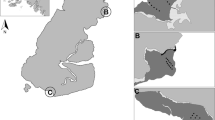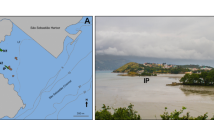Abstract
Regular daylight sampling over 13 mo (February 1985–February 1986) in and adjacent to intertidal forested areas, in small creeks and over accreting mudbanks in the mainstream of a small mangrove-lined estuary in tropical northeastern Queensland, Australia, yielded 112 481 fish from 128 species and 43 families. Species of the families Engraulidae, Ambassidae, Leiognathidae, Clupeidae and Atherinidae were numerically dominant in the community. The same species, with the addition ofLates calcarifer (Latidae).Acanthopagrus berda (Sparidae) andLutjanus agentimaculatus (Lutjanidae) dominated total community biomass. During high-tide periods, intertidal forested areas were important habitats for juvenile and adult fish, with grand mean (±1 SE) density and biomass of 3.5±2.4 fish m−3 and 10.9±4.5 g m−3, respectively. There was evidence of lower densities and less fish species using intertidal forests in the dry season (August, October), but high variances in catches masked any significant seasonality in mean fish biomass in this habitat. On ebb tides, most fish species (major families; Ambassidae, Leiognathidae, Atherinidae, Melanotaeniidae) moved to small shallow creeks, where mean (±1 SE) low-tide density and biomass were 31.3±12.4 fish m−2 and 29.0±12.1 g m−2, respectively. Large variances in catch data masked any seasonality in densities and biomasses, but the mean number of species captured per netting in small creeks was lowest in the dry season (July, August). Species of Engraulidae and Clupeidae, which dominated high-tide catches in the forested areas during the wet season, appeared to move into the mainstream of the estuary on ebbing tides and were captured over accreting banks at low tide. Accreting banks supported a mean (±1 SE) density and biomass of 0.4±0.1 fish m−2 and 1.7±0.3 g m−2, respectively, at low tide. There were marked seasonal shifts in fish community composition in the estuary, and catches in succeeding wet seasons were highly dissimilar. Comparison of fish species composition in this and three other mangrove estuaries in the region revealed significant geographic and temporal (seasonal) variation in fish-community structure. Modifications and removal of wetlands proposed for north Queensland may have a devastating effect on the valuable inshore fisheries of this region, because mangrove forests and creeks support high densities of fish, many of which are linked directly, or indirectly (via food chains) to existing commercial fisheries.
Similar content being viewed by others
Literature cited
Belbin, L. (1987). PATN pattern analysis package reference manual. CSIRO Division of Wildlife and Rangelands Research, Canberra
Bell, J. D., Pollard, D. A., Burchmore, J. J., Pease, B. C., Middleton, M. J. (1984). Structure of a fish community in a temperate tidal mangrove creek in Botany Bay, New South Wales. Aust. J. mar. Freshwat. Res. 35: 33–46
Blaber, S. J. M. (1980). Fish of the Trinity Inlet system of North Queensland with notes on the ecology of tropical Indo-Pacific estuaries. Aust. J. mar. Freshwat. Res. 31: 137–146
Blaber, S. J. M., Young, J. W., Dunning, M. C. (1985). Community structure and zoogeographic affinities of the coastal fishes of the Dampier Region of North-western Australia. Aust. J. mar. Freshwat. Res. 36: 247–266
Boto, K. G., Bunt, J. S. (1981). Dissolved oxygen and pH relationships in northern Australian mangrove waterways. Limnol. Oceanogr. 26: 1176–1178
Boto, K., Bunt, K. S., Wellington, J. T. (1984). Variations in mangrove forest productivity in northern Australia and Papua New Guinea. Estuar., cstl Shelf Sci. 19: 321–329
Conand, F. (1988). Biologie et écologie des poissons pelagiques du lagon de Nouvelle-Caledonia utilisables comme appât thonier. Office de la Recherche Scientifique et Technique Outre-Mer, rue Bayard, Paris (Editions de l'ORSTOM, Collection Etudes et Thèses)
Davis, T. L. O. (1988). Temporal changes in the fish fauna entering a tidal swamp system in tropical Australia. Envir. Biol. Fish. 21: 161–172
Dowling, R. M., McDonald, T. J. (1982). Mangrove communities of Queensland. In: Clugh, B. F. (ed.) Mangrove ecosystems in Australia. Australian National University Press, Canberra, p. 79–94
Edwards, R. R. C. (1978). Ecology of a coastal lagoon complex in Mexico. Estuar., cstl Shelf Sci. 6: 75–92
Field, J. G., Clarke, K. R., Warwick, R. M. (1982). A practical strategy for analysing multispecies distribution patterns. Mar. Ecol. Prog. Ser. 8: 37–52
Hatcher, B. G., Johannes, R. E., Robertson, A. I. (1989). Review of research relevant to conservation of shallow tropical marine ecosystems. Oceanogr. mar. Biol. A. Rev. 27: 337–414
Ingles, J., Pauly, D. (1984). An atlas of the growth, mortality and recruitment of Philippine fishes. ICLARM tech. Rep. 13: 1–127 (International Center for Living Aquatic Resources Management, Manila, Philippines)
Kay, G. (1989). Fishermen recognize 1989 as “year of the environment”. Qd Fisherman 7(5): 23–26
Kiener, A. (1966). Contributions a l'etude ecologique et biologique des eaux saumatres malgaches. Les poissons euryhalines et leur role dans developpement des peches. Vie Milieu 16(2c): 1013–1149
Krishnamurthy, K., Jeyaseelan, M. J. P. (1981). The early life history of fishes from Pichavaram mangrove ecosystem of India. Rapp. P.-v. Réun. Cons. perm. int. Explor. Mer 178: 416–423
Liem, D. S., Haines, A. K. (1977). The ecological significance and economic importance of the mangrove and estuarine communities of the Gulf Province, Papua New Guinea. Purari River (Wabo) hydro-electric scheme. Envir. Stud. 3: 1–35 (Office of Environment and Conservation, Waigani, Papua New Guinea)
Little, M. C., Reay, P. J., Grove, S. J. (1988). The fish community of an east African mangrove creek. J. Fish Biol. 32: 729–747
Pinto, L. (1987). Environmental factors influencing the occurrence of juvenile fish in the mangroves of Pagbilao, Philippines, Hydrobiologia 150: 283–301
Phillips, P. C. (1981). Diversity and fish community structure in a central American mangrove embayment. Revta Biol. trop. 29: 227–236
Quinn, N. J. (1980). Analysis of temporal changes in fish assemblages in Serpentine Creek, Queensland. Envir. Biol. Fish. 5: 117–133
Robertson, A. I. (1988a). Abundance, diet and predators of juvenile banana prawnsPenaeus merguiensis in a tropical mangrove estuary. Aust. J. mar. Freshwat. Res. 39: 467–478
Robertson, A. I. (1988b). Links between nearshore fisheries and mangroves in tropical Australia: management implications for South Pacific nations. South Pacific Commission, Nouméa, New Caledonia (Information paper No. 24. Workshop on Pacific Inshore Fishery Resources)
Robertson, A. I. (1988c). Food chains in tropical Australian mangrove habitats: a review of recent research. In: Field, C. D., Vannucci, M. (eds.) Symposium on new perspectives in research and management of mangrove ecosystems. UNDP/UNESCO, New Delhi, p. 23–36
Robertson, A. I., Alongi, D. M., Daniel, P. A., Boto, K. G. (1989). How much mangrove detritus reaches the Great Barrier Reef lagoon? Proc. 6th int. Symp. coral Reefs 2: 601–606 [Choat, J. H., et al. (eds.) Sixth International Coral Reef Symposium Executive Committee, Sydney]
Robertson, A. I., Dixon, P., Daniel, P. A. (1988). Zooplankton dynamics in mangrove and other nearshore habitats in tropical Australia. Mar. Ecol. Prog. Ser. 43: 139–150
Robertson, A. I., Duke, N. C. (1987). Mangroves as nursery sites: comparisons of the abundance and species composition of fish and crustaceans in mangroves and other nearshore habitats in tropical Australia. Mar. Biol. 96: 193–205
Saenger, P., Hegerl, E. G., Davie, J. D. S. (1983). Global status of mangrove ecosystems. Environmentalist 3: 1–88
Sasekumar, A., Chong, V. C., Leh, M. U. C. (in press). Fish and prawn communities in mangrove estuaries and mudflats in Selangor (Malaysia). In: Alcala, A. (ed.) Proceedings ASEAN-Australia Coastal Living Resources Symposium. University of the Philippines Marine Science Institute, Quezon City
Sasekumar, A., Ong, T. L., Thong, K. L. (1984). Predation on mangrove fauna by marine fishes. In: Soepadmo, E., Rao, A. N., Macintosh, D. J. (eds.) Proceedings of the Asian Symposium on Mangrove Environment: Research and Management. UNESCO, Kuala Lumpur, p. 378–384
Shenker, J. M., Dean, J. M: (1979). The utilization of an intertidal saltmarsh creek by larval and juvenile fishes: abundances, diversity and temporal variation. Estuaries 2: 154–163
Smith, P. E. (1985). Year-class strength and survival of O-group clupeoids. Can. J. Fish. aquat. Sciences 42 (Suppl. 1): 69–82
Sokal, R. R., Rohlf, F., J. (1969). Biometry. The principles and practice of statistics in biological research. W. H. Freeman & Co., San Francisco
Staples, D. H., Polzin, H. G., Heales, D. S. (1985). Habitat requirements of juvenile penaeid prawns and their relationship to offshore fisheries. In: Rothlisberg, P. C., Hill, B. J., Staples, D. J. (eds.) Second Australian National Prawn Seminar, Cleveland, Australia, p. 47–54
Stephenson, W., Dredge, M. L. C. (1976). Numerical analysis of fish catches from Serpentine Creek. Proc. R. Soc. Qd 87: 33–43
Thayer, G. W., Colby, D. R., Hettler, W. F., Jr. (1987). Utilization of the red mangrove prop root habitat by fishes in south Florida. Mar. Ecol. Prog. Ser. 35: 25–38
Warburton, K. (1978). Community structure, abundance and diversity of fish in a Mexican coastal lagoon system. Estuar. cstl mar. Sci. 7: 497–519
Weinstein, M. P. (1979). Shallow marsh habitats as primary nurseries for fish and shellfish, Cape Fear River, North Carolina. Fish. Bull. U.S. 77: 339–357
Wolanski, E., Ridd, P. (1986). Tidal mixing and trapping in mangrove swamps. Estuar., cstl Shelf Sci. 23: 759–771
Wright, J. M. (1986). The ecology of fish occurring in shallow water creeks of a Nigerian mangrove swamp. J. Fish Biol. 29: 431–441
Yanez-Arancibia, A. (1978). Taxonomia, ecologia y estructura de las communidades de peces en lagunas costeras con bocas efimeras del Pacifico de Mexico. Publnes esp. Cent. Cienc. Mar Limnol. Univ. nac. autón. México 2: 1–306
Yanez-Arancibia, A., Lara-Dominguez, A. L., Rojas-Galaviz, J. L., Sanchez-Gil, P., Day, J. W., Madden, C. J. (1988). Seasonal biomass and diversity of estuarine fishes coupled with tropical habitat heterogeneity (southern Gulf of Mexico). J. Fish Biol. 33 (Suppl. A): 191–200
Author information
Authors and Affiliations
Additional information
Communicated by G. F. Humphrey, Sydney
Contribution No. 493 from the Australian Institute of Marine Science
Rights and permissions
About this article
Cite this article
Robertson, A.I., Duke, N.C. Mangrove fish-communities in tropical Queensland, Australia: Spatial and temporal patterns in densities, biomass and community structure. Mar. Biol. 104, 369–379 (1990). https://doi.org/10.1007/BF01314339
Accepted:
Issue Date:
DOI: https://doi.org/10.1007/BF01314339




